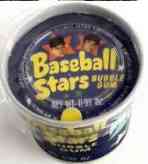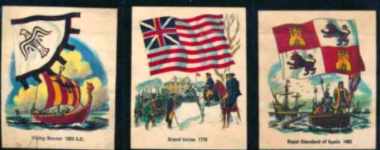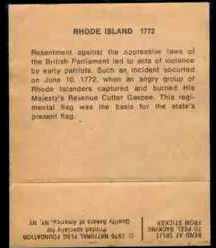1956 Topps FLAGS of the World #50 Cuba


Please wander around the website for more info, prices, values & images
on vintage baseball, football, basketball, hockey, sport and non-sports cards.
1964/1965 Challenge the Yankees
Baseball Board Game"Challenge The Yankees" was a popular baseball board game from Hasbro in 1964 & 1965.
(50) player cards: (25) Yankees and (25) All-Star opponents,
made the game a treasure trove for collectors. 4" x 5-1/2" cards
came in blank-backed perforated sheets on a fairly fragile paper
stock.
1964/1965 cards are nearly the same with a stat line the only way
to distinguish. A couple cards even have same stats so no way to tell
them apart.
Click for complete 1964/1965 Challenge the Yankees Baseball Board Game (you may be on that page now) |

1970/1972/1973 Topps Candy Lids |

1975/1976 Flag Foundation cards |

Cabinet Card Were oversized trading cards featuring paintings issued mostly 1910-1915.
Card Show is a gathering of dealers & collectors looking to buy/sell/trade sports cards and memorabilia.
Card Stock is the material a card is printed on. Usually paper-based, today companies play with the card stock and sometimes it appears to be wood or leather or see-thru acrylic ...
Cello Pack is a card pack whose wrapper is see-thru plastic. Usually the top & bottom cards are seen. Unopened cello packs showing major stars and rookies sell for heavy premiums.
Centering is the balance of the borders: top/bottom & left/right. On perfectly-centered cards, top/bottom borders match as do the left/right borders. Centering is presented as a set of numbers & directions and often included with the grade. Perfectly-centered is "50/50 t/b" AND "50/50 l/r". As centering gets worse, one number increases and the other decreases. For example: 90/10 t/b is considered extremely off-center top to bottom. The numbers add up to 100 (50/50, 60/40, 90/10 ...).
Certificate Of Authenticity (COA) A document used to verify legitimacy of a collectible. NOTE: Keep in mind that COA's are easier to fake then autographs.
Common A card of a non-star player is considered a "Common" as opposed to cards of a star players or specialty/subset cards such as league leaders, teams cards, World Series cards...
Condition (Grade) Centering, corner wear, photo clarity, edges, creases, print flaws ... all combine to determine a card's condition or grade. Along with rarity/scarcity it is the major factor in a card's value.
Crease Defect usually caused by bending the card. Hard to see, or not, a crease lowers the card's grade (VG or lower) and greatly diminishes it's value.



 Topps has tried many crazy products, called "test issues".
Mostly distributed in limited areas, test issues were scarce.
"Candy Lids" were little tubs of candy with player's photos on
bottom of a 1-7/8" lid. 10 cents/tub, 24 tubs/box.
Topps has tried many crazy products, called "test issues".
Mostly distributed in limited areas, test issues were scarce.
"Candy Lids" were little tubs of candy with player's photos on
bottom of a 1-7/8" lid. 10 cents/tub, 24 tubs/box. 

 1970 Topps Candy Lids were called "Baseball Stars Bubble Gum",
had 24 players, the 1973 Topps Candy Lids had 55.
1970 Topps Candy Lids were called "Baseball Stars Bubble Gum",
had 24 players, the 1973 Topps Candy Lids had 55.  Topps 1973 Pinups & Comics share many of the same photos.
Topps 1973 Pinups & Comics share many of the same photos.  Printed in 1976 by the National Flag Foundation specially for Quality Bakers of America, NY, NY.
1976 Quality Bakers/National Flag Foundation “Bicentennial Flag Stickers” Non-Sport- 1 Complete Set of 31 Stickers- Overall Ex-ExMt, a couple have light creases, these just have a peel-off at the corner instead of a 2 part peel-off, and also tells you to put in “your saver book” unlike the other 1976 set. This set includes different and notable flags having to do with America from 1003-1969.
https://www.baseball-cards.com/vintage-old-non-sport-cards/1975-1976-fleer-national-flag-foundation-stickers-set-2.php
Printed in 1976 by the National Flag Foundation specially for Quality Bakers of America, NY, NY.
1976 Quality Bakers/National Flag Foundation “Bicentennial Flag Stickers” Non-Sport- 1 Complete Set of 31 Stickers- Overall Ex-ExMt, a couple have light creases, these just have a peel-off at the corner instead of a 2 part peel-off, and also tells you to put in “your saver book” unlike the other 1976 set. This set includes different and notable flags having to do with America from 1003-1969.
https://www.baseball-cards.com/vintage-old-non-sport-cards/1975-1976-fleer-national-flag-foundation-stickers-set-2.php

